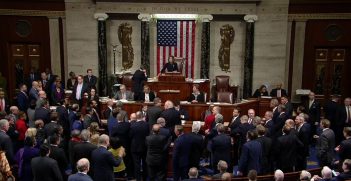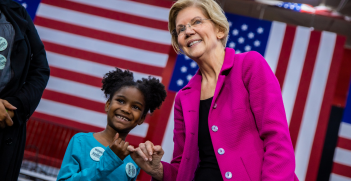From Sparring Partner to Running Mate: Kamala Harris Makes History and Offers Promise of Even More

Joe Biden’s vice-presidential pick may be the most consequential political move in his career. Kamala Harris, already a rising star of the Democratic establishment, offers a promising glimpse of the party’s future.
Just over a year ago, when the Democratic primaries campaign began to ramp up with the first TV debates, Kamala Harris was one of the darlings of both the media and voters. Her star was ascendant after the first debate, during which she sparred with and emerged victorious from a duel with the man who would end up winning the Democratic Party’s nomination and ultimately offer her to become his running mate.
Harris’ rise and fall in the lead up to the party primaries is emblematic of a trend in the marathon-long US primary campaigns. Instant political stars are born and destroyed – one week you might have a great debate performance, and the next week you are just yesterday’s news because there is always someone else with a viral soundbite who will go on to dominate the media cycle, taking the voters’ support with them.
This is basically what happened to the senator from California who, despite having a solid start in the campaign, never managed to widen her appeal, while the field of contenders kept on expanding to record levels in the recent party history. By the end of 2019, it was perfectly clear that she had run out of funds to proceed with the campaign, and there were also some ominous reports about her campaign essentially imploding as a result of poor management. Harris pulled out of the race in December 2019 without having competed in a single primary. Yet now, in comparison with past vice-presidential hopefuls Geraldine Ferraro and Sarah Palin, Harris has the greatest chance to become the first female vice president of the United States, and even its first female president should Joe Biden keep his word about being a transition candidate, ushering in the new generation of Democratic politicians.
Biden played it safe
Biden’s presidential bid can be reduced to two main principles – minimising risk and making a case that he is Trump’s true antipode. The fact that Harris ultimately prevailed as his vice-presidential pick supports both of these points. From her years as the district attorney of San Francisco and then the attorney general of California, to her more recent experience in the Senate, Harris was already considered a rising star of the Democratic Party’s establishment. Over time, her politics has grown more progressive, in lockstep with the party’s ideological consensus. Similar to Biden, she is a reformist rather than a revolutionary.
While it is abundantly clear that she is ideologically diametrically opposite to Donald Trump and his vice president, Mike Pence, her personal history and background further emphasise the difference between the two presidential tickets. As a woman of minority background, she is a perfect embodiment of the party’s future and the much touted Obama coalition, which was almost 3 million votes stronger in the 2016 elections. However, the Obama coalition only managed to bring a Pyrrhic victory to Hillary Clinton, as such discrepancy in popular votes wasn’t enough to push her across the 270 electoral college votes needed for victory.
How important is a vice-presidential pick?
While Democrats hope the Biden-Harris ticket has what it takes to win over the majority of electoral college votes, history shows that VP choice doesn’t necessarily make or break a campaign. Still though, the selection of a running mate is far from a trivial choice. Vice-presidential candidates are usually chosen on the basis of complementarity, filling in the policy and electoral map gaps that presidential nominees might have.
For instance, Barack Obama chose Biden for vice president precisely because of the latter’s extensive legislative experience and his Rust Belt credentials. Ronald Reagan picked George H. W. Bush because of Bush’s remarkable military and foreign policy pedigree at a time when the Cold War was beginning to heat up, and John F. Kennedy opted for Lyndon Johnson as his Southern Protestant roots were needed to balance and remove suspicions about JFK’s Northeastern Catholic upbringing.
However, vice-presidential picks can prove to be controversial. George W. Bush’s choice of Dick Cheney paved the way for making the latter the most powerful VPOTUS, who is to this day remembered for infamy. Even though he was unsuccessful in his last run for the White House, the late John McCain’s (some say forced) drafting of Sarah Palin was something he would later admit to regret as the choice served as a critical juncture in fanning the flames of the populist turn within the GOP.
In Biden’s case, picking Harris has already led to increased enthusiasm among the Democratic voters. However, she has not escaped their criticism, mainly owing to her professional track record within the criminal justice system, which is at odds with the party’s progressive wing. Over the coming weeks, we might expect the enthusiasm to translate into financial injections to the campaign, particularly from some of the wealthier donors from her home state of California. Yet the vast majority of Democrats have pledged to “vote blue no matter who” in 2020 as their primary motivation is to remove Trump from office. Ultimately, Biden’s choice is a reassuring signal that he understands that the party’s future leaders should begin to look more like its average voters.
The final stretch of the campaign
As the countdown to election day begins, the campaign is poised to become uglier. Senator Harris has already proven she has what it takes to sustain verbal punches, and equally, to use her prosecutorial experience to lay out a convincing case, as she did in her first joint campaign appearance with Biden. Indeed, her candidature has rendered the Trump campaign unable to formulate an effective line of attack. Given her professional record, it is hard to portray her as a socialist scarecrow, so Trump has had to reach for the unoriginal personal insults – the same ones he used against Hillary Clinton. He also faces a problem in explaining why he twice donated to Harris’ campaign when she was running for attorney general.
While political analysts should resist essentialist tropes in analysing Harris and focus on her political record rather than the standout identity lines (i.e. focusing only on her being a woman of minority background), Trump and his surrogates will be reaching for precisely these traits to mobilise the white voters’ base. Therefore, it is not surprising that he has already begun to question her citizenship and eligibility to run for president, as well as her ambition.
Electoral manipulations
The next two weeks will be devoid of the usual pomp and pageantry that party conventions bring, though they will be a good indicator of what the main campaign messages will be now that the presidential tickets are complete. President Trump has already tested the idea of postponing elections, which has been firmly rejected by both sides of the aisle. What remains then is the use of executive and legislative powers to impose a range of voting restrictions, including the latest tussle over funding the US Postal Service, which is a pivotal instrument in delivering mail-in ballots. At the same time, Trump’s team is vesting hope in some sort of last-minute economic recovery, or at least evidence of a safe and widely available COVID-19 treatment or vaccine.
Just as in 2016, Trump’s electoral chances are not nil. However, this time around, his victory seems to be even harder to fathom. In any case, given the number of Americans who will opt for postal voting, it is beyond likely that we might not know who the winner is well beyond the election night. Therefore, if Trump loses, Biden’s vice-presidential pick might prove to be the most consequential political move in his career. Harris has become the de facto leader of Democratic Party and the most likely candidate to become the first female president of the United States.
Dr Gorana Grgic is a jointly appointed lecturer at the United States Studies Centre and the Department of Government and International Relations at the University of Sydney.
This article is published under a Creative Commons Licence and may be republished with attribution.





